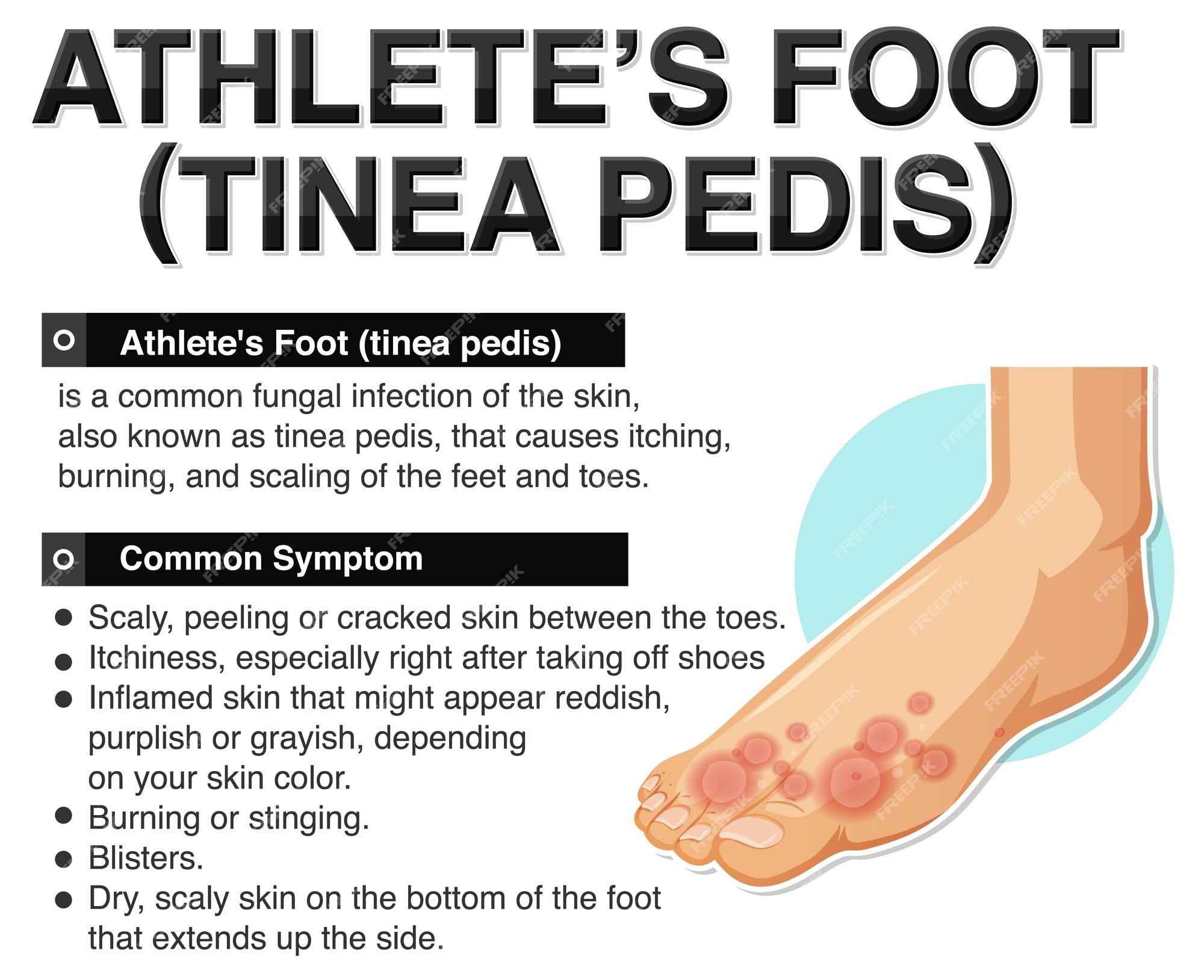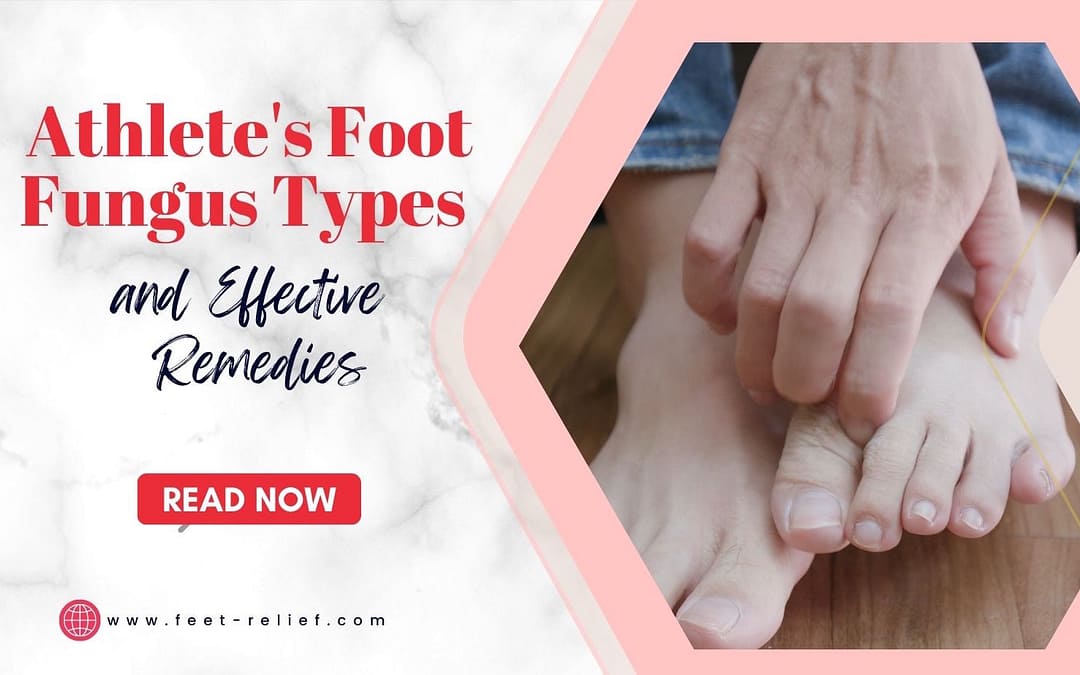Feet-Relief is supported by our audience. When you purchase through one of our links, we may earn a small affiliate commission. As an Amazon Associate I earn from qualifying purchases.Your cost is not affected.
Athlete’s foot is a common fungal infection of the feet that can cause itching, burning, scaling, and cracking of the skin. There are four main types of athlete’s foot fungus, each with its own characteristic symptoms. The most common type is toe web infection, which affects the skin between the toes. Moccasin-type infection affects the bottom of the feet, the heels, and the edges. Vesicular-type infection causes blisters on the soles of the feet. Ulcerative infection is the most severe type of athlete’s foot and can cause open sores on the feet.
In this article, we take an in-depth look at the different types of athlete’s foot fungus and discuss effective remedies for each type. We will also provide tips on how to prevent athlete’s foot from occurring in the first place. So if you are struggling with athlete’s foot, or if you are simply looking to learn more about this common condition, read on!
Know Your Foe: An In-depth Look at Different Athlete’s Foot Fungus Types and Effective Remedies

Image Source: FreeImages
Introduction to Athlete’s Foot
Athlete’s foot, medically known as tinea pedis, is a common skin infection that affects millions worldwide yearly. Despite its name, this condition is not exclusive to athletes. It can impact anyone who comes into contact with the athlete’s foot fungus types, often in wet and communal areas such as swimming pools, locker rooms, and showers.
This infection is characterized by itchy, flaky, and sometimes blistered skin, primarily occurring between the toes or on the soles of the feet. It’s caused by various fungi that love warm, damp environments – the kind of conditions commonly found inside sweaty shoes and socks.
Understanding athlete’s foot is the first step in dealing with it effectively. Its nature, causes, and symptoms must be recognized before diving into the types and treatment options available.
Is Athlete’s Foot Contagious?
One of the most frequently asked questions about this condition is, “Is athlete’s foot contagious?” The answer is a resounding yes. The fungi responsible for athlete’s foot can easily be spread through direct contact with an infected person or indirectly by touching surfaces contaminated with the fungi.
This fungus can survive on various surfaces, including towels, shoes, and floors, making it easy to contract in communal areas. It’s also possible to spread the infection to other areas of your body, such as your hands or groin, if you touch the infected area and then touch another part without washing your hands first.
Therefore, practicing good personal hygiene and taking preventative measures is crucial to avoid contracting or spreading this highly infectious condition.
What causes Athlete’s Foot?
The primary cause of athlete’s foot is a group of fungi known as dermatophytes. These fungi feed on the keratin found in the outer layer of the skin, hair, and nails. There are several types of dermatophytes, each contributing to the different athlete’s foot fungus types.
The fungi thrive best in warm, damp environments, which is why athlete’s foot is prevalent in people who frequently wear tight, non-breathable shoes and socks. Moreover, those with weakened immune systems or certain health conditions like diabetes are more susceptible to infection.
Individuals should be aware of these causes and the conducive environments for the fungus to grow to take necessary preventive measures.
Different types of fungus that cause athlete’s foot
Studying the different types of foot fungus is integral to understanding and treating athlete’s foot. The three main types of fungus are Trichophyton rubrum, Trichophyton interdigitale, and Epidermophyton floccosum.
Trichophyton rubrum is the most common cause of athlete’s foot. It often leads to a chronic infection that spreads to the toenails and hands. Trichophyton interdigitale typically causes a more acute condition characterized by scaling, peeling, and itching between the toes. Meanwhile, Epidermophyton floccosum is less common and primarily affects the soles and sides of the feet.
There are four main types of athlete’s foot fungus, each with its own characteristic symptoms:
- Toe web infection is the most common type of athlete’s foot. It affects the skin between the toes, causing redness, scaling, and cracking. The skin may also be moist and have a foul odor.
- Moccasin-type infection affects the bottom of the feet, the heels, and the edges. The skin may be red, scaly, and cracked. There may also be blisters or weeping sores.
- Vesicular-type infection causes small blisters on the soles of the feet. The blisters may be clear or filled with fluid. They often itch and may be painful.
- Ulcerative infection is the most severe type of athlete’s foot. It causes open sores on the feet. The sores may be painful and may bleed.
Understanding these distinct types can help in identifying the specific fungus responsible for the infection, thus leading to a more effective treatment.
Recognizing the symptoms of Athlete’s Foot
Recognizing the symptoms of athlete’s foot is the first step in seeking proper treatment. The symptoms can vary depending on the type of fungus causing the infection. They usually include itching, stinging, and burning between the toes or on soles of the feet, itchy blisters, cracking and peeling skin, especially between the toes and on the soles, and dry skin on the sides or bottoms of the feet.
In some cases, athlete’s foot may also lead to a secondary bacterial infection, which can cause the foot to become swollen and painful, with a foul odor. If the infection spreads to the toenails, it can cause the nails to become discolored, thick, and even crumble.
Early recognition of these symptoms can lead to a quicker diagnosis and treatment, limiting the progression of the infection.
In-depth look at treatments for the various types of foot fungus
Each type of foot fungus responsible for athlete’s foot presents itself differently and requires specific treatment. For instance, the Trichophyton rubrum infection often starts with some minor skin cracks between the toes but can spread to cover the entire foot’s sole, a condition known as moccasin athlete’s foot.
On the other hand, the infection caused by Trichophyton interdigitale typically appears as a rash that causes scaling and peeling of the skin between the toes, often accompanied by severe itchiness.
Understanding these distinctions can help individuals and healthcare providers develop more targeted treatment plans
Effective Remedies for Athlete’s Foot
There are numerous effective remedies for athlete’s foot available. Over-the-counter (OTC) topical antifungal creams, sprays, and powders such as miconazole, clotrimazole, and terbinafine are usually the first line of treatment.
For severe or persistent infections, a healthcare provider may prescribe stronger topical or oral antifungal medications. In cases where a secondary bacterial infection has occurred, antibiotics may also be necessary.
Natural remedies, including tea tree oil and garlic, have shown some effectiveness in treating athlete’s foot. However, they should not replace conventional treatments but can be used as complementary therapies.
Athlete’s Foot Treatment options
Apart from over-the-counter medications and prescription drugs, other treatment options are available for athlete’s foot. These include home remedies, preventive measures, and lifestyle changes.
For instance, keeping the feet clean and dry, wearing breathable shoes and socks, and alternating shoes can help treat and prevent the infection. Applying antifungal powder to the feet and inside shoes can also be beneficial.
A healthcare provider might suggest photodynamic therapy or laser treatments to manage the infection in severe cases. However, these treatment options are typically considered when other treatments are ineffective.
Tips for preventing Athlete’s Foot
Prevention is always better than cure. To prevent athlete’s foot, maintain good foot hygiene by washing your feet daily with soap and warm water, drying them thoroughly, especially between the toes, and changing socks regularly.
Avoid walking barefoot in public areas where the fungus might be present. Always wear flip-flops or shower shoes in communal showers, locker rooms, and around public pools. Furthermore, opt for breathable footwear to keep your feet dry and less hospitable to fungi.
Related: Understanding Athlete’s Foot
Staying one step ahead of Athlete’s Foot
Yes, athlete’s foot is a common yet irritating condition caused by various foot fungus types. Understanding the causes, recognizing the symptoms, and knowing the different athlete’s foot fungus types can help seek timely and effective treatment.
Remember, prevention is key. By practicing good foot hygiene and taking preventive measures, anyone can stay one step ahead of an athlete’s foot fungus. And remember that many effective treatments are available to help you get back on your feet.
Remember to consult with a healthcare provider if you think you have athlete’s foot, especially if you have diabetes or a weakened immune system. Stay vigilant, stay healthy, and keep your feet happy!
Read More
Amazon and the Amazon logo are trademarks of Amazon.com, Inc, or its affiliates.


